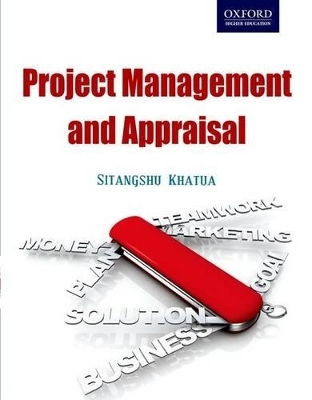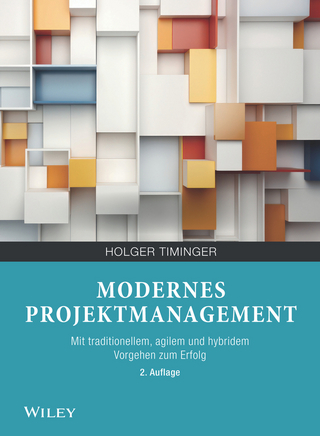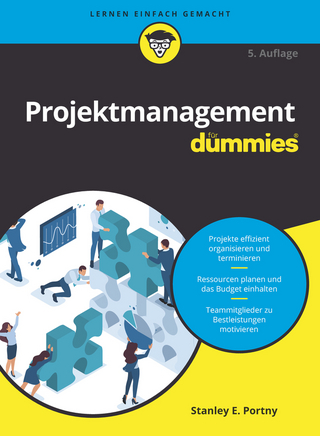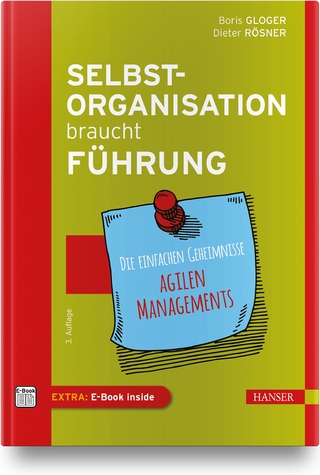
Project Management and Appraisal
OUP India (Verlag)
978-0-19-806690-3 (ISBN)
Project Management and Appraisal is a comprehensive textbook specially designed to meet the requirements of post graduate management students specializing in Finance and/or in Operations. It aims to familiarize the readers with the core concepts of project management including its planning, execution, control and appraisal.
Written with a managerial perspective, the book is divided into 4 parts. Part I, Introduction to Project Management, gives an overview of project management along with its phases, network diagrams and the microsoft project management software. Part II, Project Appraisal, elucidates about the various appraisal methods in project scanning and selection including technical, social and financial appraisal. Following this, the book discusses the fundamentals of capital budgeting decisions, risk analysis models, financial forecasting, strategies used for managing the risk and real options. The book also includes a chapter regarding project appraisal in international context. Chapters in Part III, Project Planning, Execution and Control, enumerate about the project life cycle planning, inputs required for project planning and the reasons for cost and time over-run. This part, also, explores the execution, including budgeting and scheduling, and the importance of control and audit of a project. Management of e-projects and the future of project management are covered in Part IV, Project Management-The Future. The book also includes appendices on regulatory framework in project appraisal, tables on the several discounted & compounded factor for various rate & time periods and the detailed project report.
Owing to its comprehensive coverage and approach, students will find this book valuable. It will also serve as a veritable guide for the professionals because of the various case study discussions.
Sitangshu Khatua, presently Associate Professor (Finance) and Head (Academics and MDP) at Jyotirmoy School of Business, Kolkata has a total experience of 14 years working both in the industry as well as in academics. He is also a visiting faculty at IIFT & Strategy Academy, Kolkata and a fellow participant at XLRI in his final thesis stage. He has been conducting corporate training and MDPs for the executives of NTPC, IFB, IOC, RITES, Ultratech and many more since 2000. He was also a part of the project on SME financing in India under National Productivity Council and Recruitment activity under Jharkhand Educational Council. He has presented many papers in National and International conferences and published articles in peer review journals.
PART - I: INTRODUCTION TO PROJECT MANAGEMENT ; 1. PROJECT MANAGEMENT : FUNCTIONS, ATTRIBUTES AND PROCESSES ; 1.1 What is a Project ; 1.2 Features of a Project ; 1.3 Project Life Cycle ; 1.4 A Project Management Sample ; 1.5 The Project Manager - Role in other Functional areas of Management ; 1.6 Project Management now-a days: A Holistic perspective ; 2. PROJECT MANAGEMENT - AN OVERVIEW ; 2.1 Introduction ; 2.2 Phases of Project Management & Network Diagrams - Guidelines ; 2.3 Critical Path Method (CPM) ; 2.4 Gantt Chart / Time Chart ; 2.5 Program Evaluation & Review Technique (PERT) ; 2.6 Crashing of Project Network ; 2.6.1 Guidelines of Network crashing ; 2.6.2 Crashing of Project network with Costs Trade-off ; 2.7 Project Scheduling with constrained resources ; 2.7.1 Resource Leveling Technique ; 2.7.2 ; RESOURCE ALLOCATION TECHNIQUE ; 2.8 Graphical Evaluation & Review Technique (GERT) ; 2.9 Project Management Software ; PART - II : PROJECT APPRAISAL ; 3 GENERATION OF PROJECT IDEAS ; 3.1 Scouting for opportunities & ideas ; 3.2 Resource allocation at the Corporate Level ; 3.3 Resource allocation at the Business unit level ; 3.3.1 Pest Analysis ; 3.3.2 Porter's Model ; 3.3.3 Value Chain Analysis ; 3.3.4 Portfolio Analysis ; 3.3.5 Flexibility Analysis ; 3.3.6 Creativity & Idea Generation ; 4 VARIOUS APPRAISAL METHODS IN PROJECT SCANNING & SELECTION ; 4.1 Market Appraisal ; 4.1.1 Target Market Identification ; 4.1.2 Market Survey ; 4.1.3 Demand forecasting using Primary & Secondary data ; 4.1.4 Projection of demand using Qualitative & Quantitative models ; 4.2 Technical Appraisal ; 4.2.1 Project Purchase Management ; 4.2.2 Vendor Selection & Contract administration ; 4.2.3 Procurement of Equipment & Materials ; 4.2.4 Plant Capacity & Location ; 4.2.5 Project Layouts & Work Schedule ; 4.3 Environmental Appraisal ; 4.3.1 Environment & Pollution ; 4.3.2 Pollution Prevention ; 4.3.3 Environmental Regulation regarding Project ; 4.4 Social Appraisal ; 4.4.1 S C B A ; 4.4.2 UNIDO approaches ; 4.4.3 LM approaches ; 4.4.4 CSR in Project Management ; 4.4.5 PSU investments ; 5 FINANCIAL APPRAISAL IN PROJECT SCANNING & SELECTION ; 5.1 Time Value of Money ; 5.1.1 Overview ; 5.1.2 Basis of Time Value ; 5.1.3 Compounded or Future Value ; 5.1.4 Discounted or Present Value ; 5.1.5 Annuity ; 5.2 Cost of Capital ; 5.2.1 Overview ; 5.2.2 Opportunity Cost of Capital ; 5.2.3 Cost of Equity ; 5.2.4 Cost of Debt ; 5.2.5 Cost of Preference Capital ; 5.2.6 WACC ; 5.2.7 Marginal and Average Cost of Capital ; 5.2.8 Factors affecting Cost of Capital ; 5.3 Fundamentals of Capital Budgeting Decisions ; 5.3.1 Need of Capital Budgeting decisions ; 5.3.2 Value Creation & Corporate Investment ; 5.3.3 Investment Appraisal Techniques Non DCF & DCF Table/Chart ; 5.3.4 Various Methods of Investment Appraisal Techniques ; 5.3.5 Comparative Analysis of Investment Appraisal Techniques ; 5.3.6 Ranking Problem (IRR vis-a-vis NPV-a conceptual clarification) ; 5.3.7 ; MODIFIED INTERNAL RATE OF RETURN (MIRR) ; 5.3.8 ; A CASE STUDY ON SIMPLE CAPEX DECISION ; 5.3.9 ; MINI CASE FOR PRACTICE ; 5.3.10 IRR-A Blunder-but still it is popular ; 5.3.11 Replacement decisions ; 5.3.12 The Optimal Capital Budget ; 6 SELECTION OF EXACT DISCOUNT FACTOR ; 6.1 Cost of Capital can be discount factor ; 6.2 IRR & Cost of Capital ; 6.3 Inflation & Capital Budgeting ; 6.4 Project Cash Flows ; 6.5 Most appropriate discount rate ; 6.6 A P V - Adjusted Present Value ; 6.7 W A C C - Weighted Average Cost of Capital ; 6.8 Interest & Depreciation ; 7 RISK ANALYSIS MODELS IN CAPITAL BUDGETING ; 7.1 What is Risk ; 7.2 Project Risk Management ; 7.3 Simple Probability Analysis ; 7.4 Sensitivity Analysis ; 7.5 Scenario Analysis ; 7.6 Break-Even Analysis ; 7.7 Certainty Equivalent Method ; 7.8 Risk Adjusted Discount Rate Method ; 7.9 Hiller Model ; 7.10 Simulation Analysis ; 7.11 Decision Tree Analysis ; 7.12 Capital Rationing ; 7.13 Risk & Utility ; 7.14 Portfolio Theory & Capital Budgeting ; 7.15 Capital Asset pricing model & capital budgeting ; 8 FINANCIAL FORECASTING ; 8.1 Financial Forecasting ; 8.2 Percentage of Sales Method ; 8.3Proforma Forecasting Technique ; 8.4 Growth & External Fund requirement ; 8.5 Multi-year Projection Illustration ; 8.6 Estimating Future Sales Revenues - The tricks of the trade ; 9 FINANCING STRATEGY ; 9.1 Cost of Project ; 9.2 Means of Finance ; 9.3 Capital Structure ; 9.4 Infrastructure Financing ; 9.5 Project Stakeholders ; 9.6 Project Contracts ; 9.7 Managing the Risk of Financing big Infrastructure Projects ; 9.8 Financing in a big Project ; 9.9 Venture Capital in Project Finance ; 9.10 Leasing - An illustration ; 9.11 Income Tax interface ; 10 REAL OPTIONS ; 10.1 Introduction ; 10.2 History of Real Options ; 10.3 Classification ; 10.4 Binomial Model ; 10.5 Black & Scholes Option Pricing formula ; 10.6 Link between Investment and Black & Scholes Inputs ; 10.7 Option to Expand : Illustration ; 10.8 Option to Abandon : Illustration ; 10.9 Luehrman's Tomato Garden ; 10.10 Examples of increasing Project value by delaying the project ; 10.11 Singur - A journey from traditional NPV to Real Options ; 10.12 Real Concerns & conclusions ; 11 MULTIPLE PROJECT CONSTRAINTS ; 11.1 Conflict in Ranking - various cases ; 11.2 Solution of the conflict in Ranking ; 11.3 Capital Rationing ; 11.4 Technique for selecting more than one project from a group ; 11.5 Linear Programming approach ; 11.6 Integer Programming Approach ; 11.7 Goal Programming approach ; 12 INTERNATIONAL PROJECT APPRAISAL ; 12.1 Project Appraisal in the International context ; 12.2 Reasons for Cross-border investing ; 12.3 Foreign Exchange exposure from Foreign Direct investment & Cost of Capital ; 12.4 Adjusted Present Value Approach ; 12.5 Managing exposure of FDI to political risk ; 12.6 Relationship between the CAPM & Black-Scholes Option pricing formula ; 12.7 International Joint Ventures ; PART - III : PROJECT PLANNING, EXECUTION & CONTROL ; 13 PROJECT PLANNING ; 13.1 What is Project Planning & why is it necessary ; 13.2 The process of Planning ; 13.3 Components of a good Plan ; 13.4 Project Life cycle planning ; 13.5 Inputs required for Project Planning ; 13.6 Why does a Project fail ; 13.7 Reason behind time over-run & cost over-run ; 14 PROJECT EXECUTION ; 14.1 Project Organization ; 14.2 Project Staffing ; 14.3 Project Budgeting ; 14.4 Project Scheduling ; 15 PROJECT CONTROL & AUDIT ; 15.1 Project Monitoring & Control ; 15.2 Termination of a Project ; 15.3 Project Audit ; PART - IV : PROJECT MANAGEMENT - THE FUTURE ; 16 MANAGING E-PROJECT ; 16.1 What is e-Project ; 16.2 Planning of e-Project ; 16.3 Resource analysis of e-project ; 16.4 Cost of e-Project ; 16.5 Valuation of e-Project ; 16.6 Financing of e-Project ; 16.7 Future of e-Project ; 17 FUTURE OF PROJECT MANAGEMENT ; 17.1 ; CAREER PATH IN PROJECT MANAGEMENT ; 17.2 ; EMERGENCE OF PROJECT-DRIVEN ORGANIZATIONS - CURRENT TRENDS ; 17.3 ; PROJECT MANAGEMENT MATURITY MODEL ; 17.4 ; PROJECT MANAGEMENT IN ACTION: ; 17.5 ; PROJECT MANAGEMENT IN ACTION: ; 17.6 ; CONTEMPORARY ISSUES IN PROJECT MANAGEMENT ; PART - V ; APPENDIX I : REGULATORY FRAMEWORK IN PROJECT APPRAISAL ; APPENDIX II : TABLES ; ON SEVERAL DISCOUNTED & COMPOUNDED FACTOR FOR VARIOUS RATE & TIME PERIODS ; APPENDIX III : DETAILED PROJECT REPORT
| Verlagsort | New Delhi |
|---|---|
| Sprache | englisch |
| Maße | 187 x 242 mm |
| Gewicht | 870 g |
| Themenwelt | Wirtschaft ► Betriebswirtschaft / Management ► Projektmanagement |
| ISBN-10 | 0-19-806690-2 / 0198066902 |
| ISBN-13 | 978-0-19-806690-3 / 9780198066903 |
| Zustand | Neuware |
| Haben Sie eine Frage zum Produkt? |
aus dem Bereich


